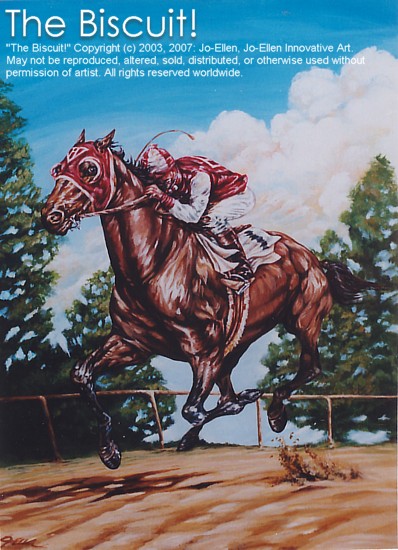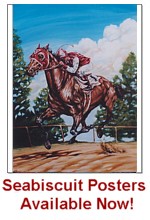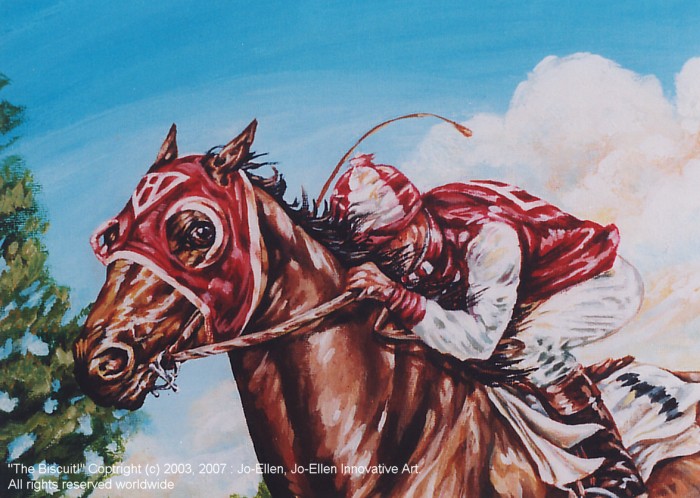|
"The Biscuit!"
Acrylic Paint
18" x 24"
____________Original Art by Jo-Ellen___________
 Seabiscuit ; a story behind the painting:
As a youth in late 1970's America, I occasionally heard my elders mention a horse named Seabiscuit.
They would describe him with genuine awe and usually brought him up in comparison to other great
horses of the day, generally with his modern "rivals" falling short in iconic stature of "The Biscuit".
Nearly forty years after his last race, in an era that included "Super-horses" the likes of Secretariat, Seattle, Slew, and Affirmed [to mention a few]
people were still praising Seabiscuit. How could a horse inspire a people to such feelings of hope during times of despair?
It happened with Secretariat at a time when a country lost too many of it’s sons in ‘conflict’, was torn by injust difference, and
political strife. Just when a world seemed to be falling apart, Secretariat became a focus guiding people to the probability
of a better day, a better destiny. People still talk of Secretariat thirty years after his triumphant triple crown with admiration,
but they also still speak of an unlikely champion from sixty-some-odd years past. Once upon a time, In a ravaged nation
nearly broken by Depression, there was formed an alliance of seemingly insignificant under-dogs with little prospect:
Seabiscuit ; a story behind the painting:
As a youth in late 1970's America, I occasionally heard my elders mention a horse named Seabiscuit.
They would describe him with genuine awe and usually brought him up in comparison to other great
horses of the day, generally with his modern "rivals" falling short in iconic stature of "The Biscuit".
Nearly forty years after his last race, in an era that included "Super-horses" the likes of Secretariat, Seattle, Slew, and Affirmed [to mention a few]
people were still praising Seabiscuit. How could a horse inspire a people to such feelings of hope during times of despair?
It happened with Secretariat at a time when a country lost too many of it’s sons in ‘conflict’, was torn by injust difference, and
political strife. Just when a world seemed to be falling apart, Secretariat became a focus guiding people to the probability
of a better day, a better destiny. People still talk of Secretariat thirty years after his triumphant triple crown with admiration,
but they also still speak of an unlikely champion from sixty-some-odd years past. Once upon a time, In a ravaged nation
nearly broken by Depression, there was formed an alliance of seemingly insignificant under-dogs with little prospect:
"In 1938, near the end of a decade of monumental turmoil, the year's number-one newsmaker was not Franklin Delano
Roosevelt, Hitler, or Mussolini. It wasn't Pope Pius XI, nor was it Lou Gehrig, Howard Hughes, or Clark Gable.
The Subject of the most newspaper column inches in 1938 wasn't even a person. It was an undersized,
crooked-legged racehorse named Seabiscuit.
In the latter half of the Depression, Seabiscuit was nothing short of a cultural icon in America, enjoying
adulation so intense and broad based that it transcended sport. When he raced, his fans choked local roads,
poured out of special cross- country "seabiscuit Limited" trains, packed the hotels, and cleaned out restaurants.
They tucked their Roosevelt dollars into Seabiscuit wallets, bought Seabiscuit hats on Fifth Avenue, played at
least nine parlor games bearing his image. Tuning in to radio broadcasts of his races was a weekly ritual across
the country, drawing as many as forty million listeners. His appearances smashed attendance records
at nearly every major track and drew two of the three largest throngs ever to see a
horse race in the United States' In an era when the United States population was less than half it's current
size, seventy eight thousand people witnessed his last race, a crowd comparable to those
at today's Super Bowls. As many as forty thousand fans mobbed tracks just to watch his workouts,
while thousands of others braved ice storms and murderous heat to catch a glimpse of his private eighty foot Pullman
railcar. He galloped over Manhattan on massive billboards and was featured week after week, year after
year, in Time, Life, Newsweek, Look, Pic, and The New Yorker.
His trainer, jockey, and owner became heroes in their own right.Their every move was painted by the glare of flashbulbs.
They had come from nowhere. The horse, a smallish, mud-colored animal with fore-legs that didn't straighten all
the way, spent nearly two years floundering in the lowest ranks of racing, misunderstood and mis-handled.
His jockey, Red Pollard, was a tragic faced young man who had been abandoned as a boy at a makeshift racetrack
cut through a Montana hay field. He came to partnership with Seabiscuit after years as a part-time prizefighter and
failing jockey, lugging his saddle through myriad places, getting punched bloody in cow-town boxing rings,
sleeping on stall floors. [Pollard rode with a body devastated by injury and blind in one]. Seabiscuit's trainer,
a mysterious, virtually mute mustang breaker named Tom Smith, was a refugee from the vanishing frontier, bearing
with him generations of lost wisdom about the secrets of horses. Seabiscuit's owner, a broad, beaming former
cavalryman named Charles Howard, had begun his career as a bicycle mechanic before parlaying 21 cents into an
automotive empire.
In 1936...recognizing the talent dormant in the horse and in one
another, they began a rehabilitation of Seabiscuit that would lift him, and them, from obscurity...
For the Seabiscuit crew and for America, it was the beginning of five up-raorious years of anguish
and exultation. From 1936 to 1940, Seabiscuit endured a remarkable run of bad
fortune, conspiracy, and injury to establish himself as one of history's most extraordinary athletes.
...he shipped more than fifty thousand exhausting railroad miles, carried staggering weight to
victory against the best horses in the country, and shattered more than a dozen track records...
Along the way, the little horse and the men who rehabilitated him captured the American imagination.
It wasn't just greatness that drew the people to them. It was their story." *
The details for their story are so compelling that were it not true, it would be impossible to believe.
While reading Laura Hillenbrand’s : "Seabiscuit, An American Legend", I was grateful that she had chosen
to bring his legacy to light again. How could anyone forget or deprive future generations of this phenomenal
story? To relive it through her words was a treat to the soul and the spirit of ‘being’. Most of us are, after all,
under-dogs with our own set of challenges in life to over-come. The story of each character gave me much
hope in my own aspirations and struggles. On the pages, there were Seabiscuit, Pollard, Charles and Marcela Howard, Smith,
and George Wolff[Seabiscuits' match race jockey during Pollards' most devastating injury]
inspiring again, much like they must have done nearly sixty years ago. My admiration for their extraordinary
recount was the reason for creating the painting presented here. For those who’s only way is via ‘sheer will’,
and because "heart" matters, may their legacy never come to pass. For once and again, inspiration
lives in a legend known as "The Biscuit".
Please feel welcome to contact/question/comment the artist via :

Copyright © 2003-2013: Jo-Ellen - all rights reserved worldwide (see below)
*Excerpt from Preface of Seabiscuit An American Legend, Copyright ©
2001-2013: By Laura Hillenbrand

Amazing Seabiscuit Gifts for EVERYONE!

A Legend In Our Time - [click for details]

Hard To Find Man O' War Apparel & Gifts!

The Greatest Legends That Ever Ran - Get YOURS Here!

Only 11 Horses To Claim The Crown - Get Them NOW!

QUICK,EASY, SAFE, and GUARANTEED!


|



